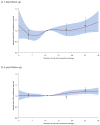Duration of red blood cell storage and survival of transfused patients (CME)
- PMID: 20158690
- PMCID: PMC3201703
- DOI: 10.1111/j.1537-2995.2010.02583.x
Duration of red blood cell storage and survival of transfused patients (CME)
Erratum in
- Transfusion. 2010 Aug;50(8):1857
Abstract
Background: Disquieting reports of increased complication and death rates after transfusions of red blood cells (RBCs) stored for more than 14 days prompted us to perform an observational retrospective cohort study of mortality in relation to storage time.
Study design and methods: We conducted a cohort study utilizing data on all recipients of at least one RBC transfusion in Sweden and Denmark between 1995 and 2002, as recorded in the Scandinavian Donations and Transfusions (SCANDAT) database. Relative risks of death in relation to storage time were estimated using Cox regression, adjusted for several possible confounding factors.
Results: After various exclusions, 404,959 transfusion episodes remained for analysis. The 7-day risk of death was similar in all exposure groups, but a tendency for a higher risk emerged among recipients of blood stored for 30 to 42 days (hazard ratio, 1.05; 95% confidence interval [CI], 0.97-1.12), compared to recipients of blood stored for 10 to 19 days. With 2-year follow-up, this excess remained at the same level (hazard ratio, 1.05; 95% CI, 1.02-1.08). No dose-response pattern was revealed and no differential effect was seen when the analyses were restricted to recipients of leukoreduced units only.
Conclusion: Although a small excess mortality was noted in recipients of the oldest RBCs, the risk pattern was more consistent with weak confounding than with an effect of the momentary exposure to stored RBCs. It seems, thus, that any excess mortality conferred by older RBCs in the combined Swedish and Danish transfusion recipient population is likely less than 5%, which is considerably smaller than in the hitherto largest investigation.
Conflict of interest statement
Conflicts of interest: We declare no conflicts of interest
Figures


References
-
- Zimrin AB, Hess JR. Current issues relating to the transfusion of stored red blood cells. Vox Sang. 2009;96:93–103. - PubMed
-
- Tinmouth A, Fergusson D, Yee IC, Hebert PC. Clinical consequences of red cell storage in the critically ill. Transfusion. 2006;46:2014–27. - PubMed
-
- Card RT. Red cell membrane changes during storage. Transfus Med Rev. 1988;2:40–7. - PubMed
-
- Nakao M, Nakao T, Yamazoe S. Adenosine triphosphate and maintenance of shape of the human red cells. Nature. 1960;187:945–6. - PubMed
-
- Valeri CR, Hirsch NM. Restoration in vivo of erythrocyte adenosine triphosphate, 2,3-diphosphoglycerate, potassium ion, and sodium ion concentrations following the transfusion of acid-citrate-dextrose-stored human red blood cells. J Lab Clin Med. 1969;73:722–33. - PubMed
Publication types
MeSH terms
Grants and funding
LinkOut - more resources
Full Text Sources
Other Literature Sources

